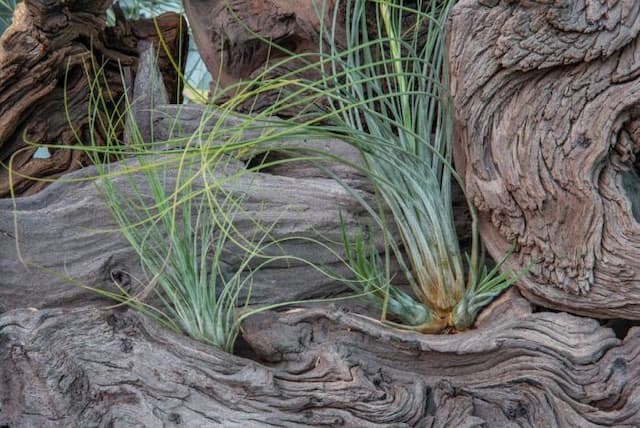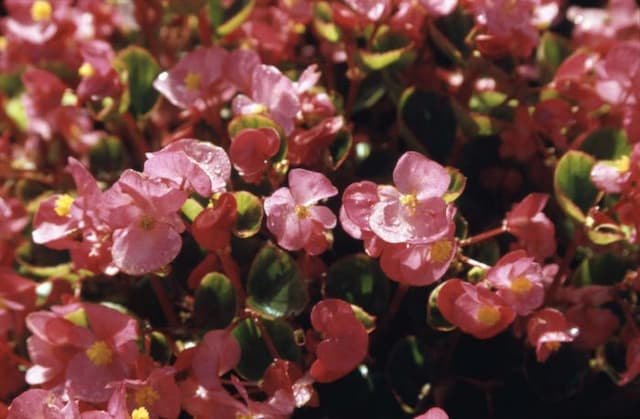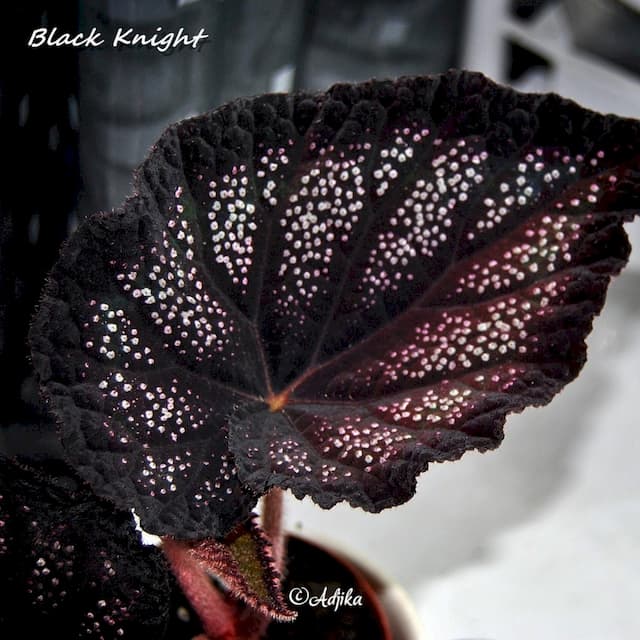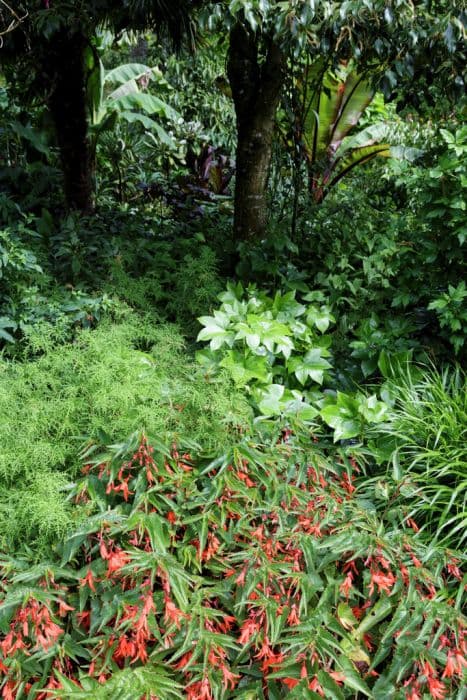Midnight Magic Begonia Begonia 'Midnight Magic' (R)

ABOUT
Begonia 'Midnight Magic' is characterized by its striking foliage and elegant, sophisticated appearance. The leaves of this plant are a deep shade of almost velvety burgundy-black, giving the plant a dark and mysterious allure. Each leaf boasts a unique shape, often broadly wing-like with a combination of sharp points and smooth curves along the edges, adding to its enchanting visual texture. Adding contrast to the dark foliage, the leaves typically feature prominent red undersides, which can be especially attractive when the leaves catch the breeze and reveal a flash of their vibrant reverse. The surface of the leaves may also be adorned with a slight iridescent sheen or subtle hints of green, catching the light to create a gentle sparkle effect. During its blooming season, the Begonia 'Midnight Magic' produces delicate flowers. These blooms provide a stark contrast to the dark leaves, with their lighter shades varying from pale pinks to whites. The flowers are modest in size but stand out against the backdrop of the dark foliage with an unassuming grace. Overall, the appearance of Begonia 'Midnight Magic' exudes a sense of dramatic flair, making it a sought-after specimen for plant enthusiasts who appreciate its unique color palette and the mysterious ambiance it brings to any space it inhabits.
About this plant
 Names
NamesFamily
Begoniaceae
Synonyms
Midnight Magic Begonia
Common names
Begonia 'Midnight Magic' (R).
 Toxicity
ToxicityTo humans
Begonias, including the Begonia 'Midnight Magic', contain insoluble oxalates which can be toxic when ingested. If parts of the plant are eaten, it can result in symptoms like irritation of the mouth, lips, tongue, and throat; this may lead to difficulty swallowing, drooling, and vomiting. In rare cases, ingestion can cause severe digestive upset. It is advisable to keep begonias out of reach of children who might accidentally ingest the plant parts.
To pets
Begonias, such as the Begonia 'Midnight Magic', are toxic to pets due to the insoluble oxalates they contain. If a pet ingests parts of the plant, it can lead to symptoms including oral irritation, pawing at the face, drooling, vomiting, and in severe cases, difficulty swallowing. It is recommended to keep begonias away from pets to prevent accidental ingestion and potential poisoning.
 Characteristics
CharacteristicsLife cycle
Perennials
Foliage type
Evergreen
Color of leaves
Mixed
Flower color
Pink
Height
1 foot 2-3 feet [30-90 cm]
Spread
1 foot 2 feet [30-60 cm]
Plant type
Herb
Hardiness zones
10
Native area
Central and South America
Benefits
 General Benefits
General Benefits- Aesthetic Appeal: Adds a unique, eye-catching visual to gardens and indoor displays with its dark foliage and contrasting blooms.
- Low Maintenance: Typically requires minimal care, making it a suitable choice for busy or inexperienced gardeners.
- Drought Tolerance: Once established, it can tolerate short periods of dryness, reducing the need for frequent watering.
- Compact Growth: Its growth habit is typically compact, making it a great option for smaller gardens or spaces.
- Versatility: Can be used in a variety of settings including containers, borders, and as indoor houseplants.
- Pest Resistant: Often resistant to many common garden pests, reducing the need for chemical treatments.
 Medical Properties
Medical PropertiesThis plant is not used for medical purposes.
 Air-purifying Qualities
Air-purifying QualitiesThis plant is not specifically known for air purifying qualities.
 Other Uses
Other Uses- Photography Prop: Begonia 'Midnight Magic' with its dark foliage can be used as a contrasting backdrop or subject in macro photography, offering a dramatic touch.
- Artistic Inspiration: Artists may draw inspiration from the deep hue of the leaves and the overall form and texture, which could be reflected in paintings, drawings, or textile designs.
- Education: This plant can be used as a teaching tool in horticulture classes to illustrate hybridization, plant breeding, and the importance of patenting plant varieties.
- Collector's Item: Due to its unique appearance, it can be sought after by plant collectors, adding value to specialized plant collections.
- Theme Gardens: The dark foliage of Begonia 'Midnight Magic' makes it suitable for Gothic-themed gardens or Halloween displays.
- Color Contrast in Landscaping: Used in landscape design where a stark color contrast is desired, it acts as an excellent foil for brightly colored plants.
- Container Gardening: Can be grown in decorative pots as part of a container garden display on patios or balconies.
- Culinary Decoration: Although typically not eaten, the leaves could be used as an unconventional garnish for culinary presentation due to their striking appearance.
- Crafting: The leaves and flowers can be used in dried flower arrangements or pressed flower art due to their distinctive color and shape.
- Feng Shui: In certain cultures, plants like Begonia 'Midnight Magic' might be used to balance the energy in a room or garden according to Feng Shui principles.
Interesting Facts
 Feng Shui
Feng ShuiThe Begonia is not used in Feng Shui practice.
 Zodiac Sign Compitability
Zodiac Sign CompitabilityThe Begonia is not used in astrology practice.
 Plant Symbolism
Plant Symbolism- Cautiousness - Begonias, in general, have been associated with being cautious or wary. This might originate from the fact that some begonias can be toxic if ingested, prompting a sense of caution in their handling and care.
- Uniqueness - The 'Midnight Magic' variety of Begonia features a distinctive dark foliage, which can be seen as a representation of individuality and the beauty of standing out from the crowd.
- Harmony - Begonias often represent harmony, possibly due to their symmetry and balance in leaf and flower growth, thus the 'Midnight Magic' can also symbolize a harmonious blend of colors and textures.
- Mystery - The deep, almost black leaves of the 'Midnight Magic' Begonia give it a mysterious vibe, often associated with the unknown or the magical aspects of the night.
 Water
WaterTo properly water a Dragon Wing Begonia, allow the soil to dry slightly between waterings. Water thoroughly when the top inch of soil feels dry to the touch, roughly once a week, but frequency can vary based on environmental conditions like heat and humidity. Each watering should consist of enough water to moisten the soil throughout the pot, which might be about 16 to 24 ounces for a standard indoor pot size. Avoid letting the plant sit in standing water as this can lead to root rot. During winter, reduce watering frequency as plant growth slows down.
 Light
LightDragon Wing Begonias prefer bright, indirect light away from direct afternoon sunlight which can scorch their leaves. They thrive in east or west-facing windows where they receive some gentle morning or evening sunlight. If growing indoors, a spot that gets 4 to 6 hours of filtered light per day is ideal for keeping your Dragon Wing Begonia healthy and encouraging vibrant leaf coloration.
 Temperature
TemperatureDragon Wing Begonias flourish in temperatures between 60 to 75 degrees Fahrenheit and should not be exposed to temperatures below 50 degrees Fahrenheit as they are sensitive to cold. The ideal indoor temperature is around 70 degrees Fahrenheit, which is comfortable for most households, to promote healthy growth. They cannot tolerate frost and should be kept in a warm environment during the colder months.
 Pruning
PruningPruning Dragon Wing Begonias encourages bushier growth and should be done when the plant begins to look leggy or after a bloom cycle to promote new flowers. Use clean, sharp scissors to remove dead or dying leaves and to shape the plant, ideally in late winter or early spring before new growth begins. Pruning once or twice a year is usually sufficient to maintain a healthy and aesthetically pleasing plant.
 Cleaning
CleaningAs needed
 Soil
SoilThe ideal soil mix for Begonia 'Midnight Magic' should be well-draining and rich in organic matter, such as a combination of peat moss, pine bark, and perlite. Soil pH should be slightly acidic, ranging from 5.5 to 6.5 to allow optimal nutrient uptake and plant health.
 Repotting
RepottingBegonia 'Midnight Magic' should be repotted every 1-2 years or when the plant appears to be root-bound. Fresh soil replenishes nutrients and provides space for growth, ensuring the plant's health and vitality.
 Humidity & Misting
Humidity & MistingBegonia 'Midnight Magic' thrives in high humidity conditions, ideally between 50% to 70%. Maintaining this humidity range will help promote lush foliage and robust growth.
 Suitable locations
Suitable locationsIndoor
Place in bright, indirect light and maintain high humidity.
Outdoor
Shelter from harsh sun; keep moist in warm, shaded area.
Hardiness zone
10-11 USDA
 Life cycle
Life cycleBegonia 'Midnight Magic' begins its life as a seed, germinating in warm, moist soil where it establishes its root system. As a seedling, it prioritizes leaf development, growing its characteristic dark, velvety foliage. The plant then enters the vegetative stage, where it matures and expands in foliage, occasionally being pinched or pruned to encourage bushier growth. Following the juvenile phase, it reaches maturity and starts its reproductive phase, developing clusters of delicate flowers that can be pink, white, or red, depending on the variety, attracting pollinators and sometimes capable of producing viable seed. After flowering, if conditions are not favorable or at the end of the growing season, the plant may enter a period of dormancy, particularly in cooler climates, during which growth slows or stops and the plant conserves energy. With the return of favorable conditions, Begonia 'Midnight Magic' can resume its growth cycle, or if it was an annual variety, the cycle concludes, relying on seed for propagation.
 Propogation
PropogationPropogation time
Spring-Summer
The Begonia 'Midnight Magic', a striking plant known for its dark foliage and blooms, can be propagated by various methods, including seed, division, leaf cuttings, and stem cuttings. However, the most popular and effective method for this plant is through stem cuttings. During the active growing season, typically from spring to summer, is the ideal time to propagate to ensure the cuttings have the best chance to root and grow. To do this, select a healthy stem with at least two nodes and cut it just below a node using a sterilized pair of scissors or a knife. Leaves on the lower part of the cutting should be removed, especially if they will be submerged when placed in water or soil. The cutting can then be placed in water or a rooting medium such as a mix of peat and perlite. If rooting in soil, the environment should be kept humid by covering the pot with a plastic bag and placing it in bright, indirect light. Roots typically emerge within a few weeks, after which the cutting can be potted into regular potting soil and cared for as a mature plant.

![Begonia [Allure]](/_next/image?url=https%3A%2F%2Fplants-admin.emdemapps.com%2Fimages%2Fplants%2F%2Fimages%2F604b5b9006ab9.png&w=640&q=75)







